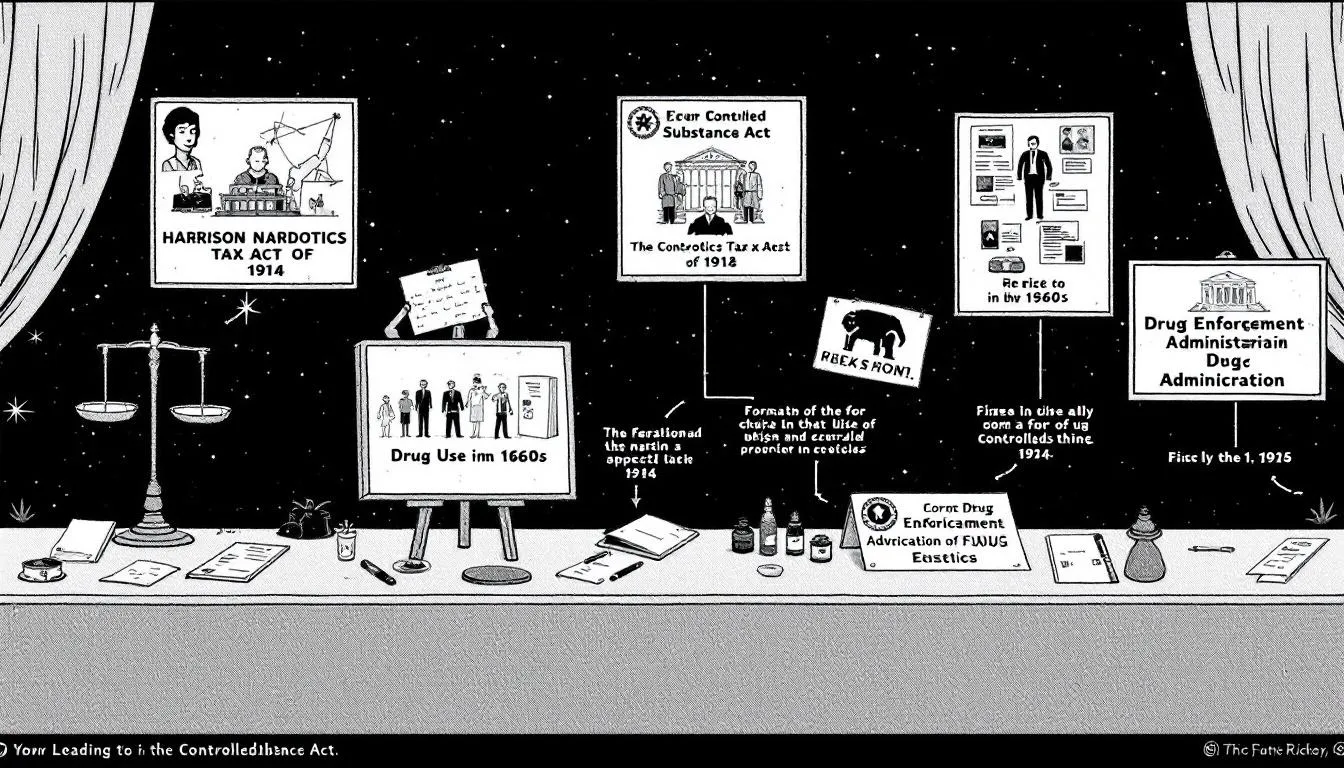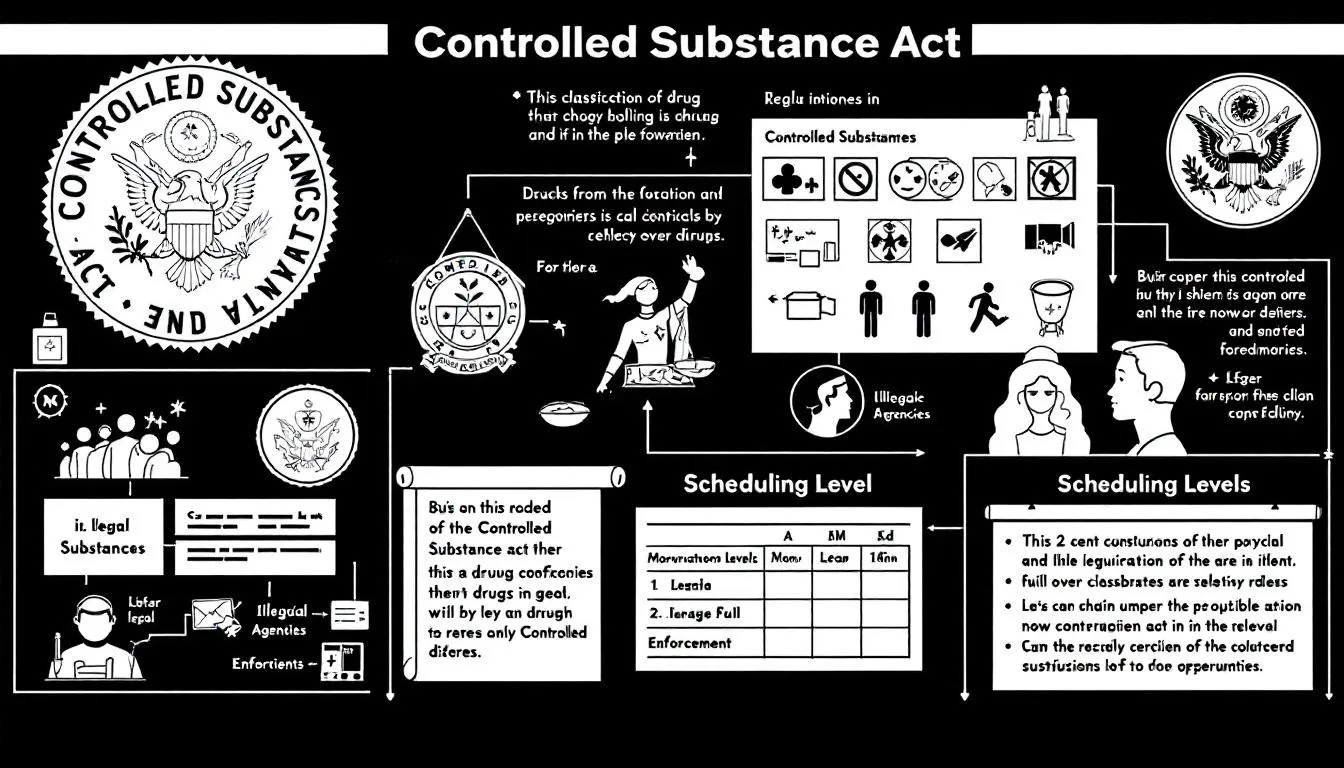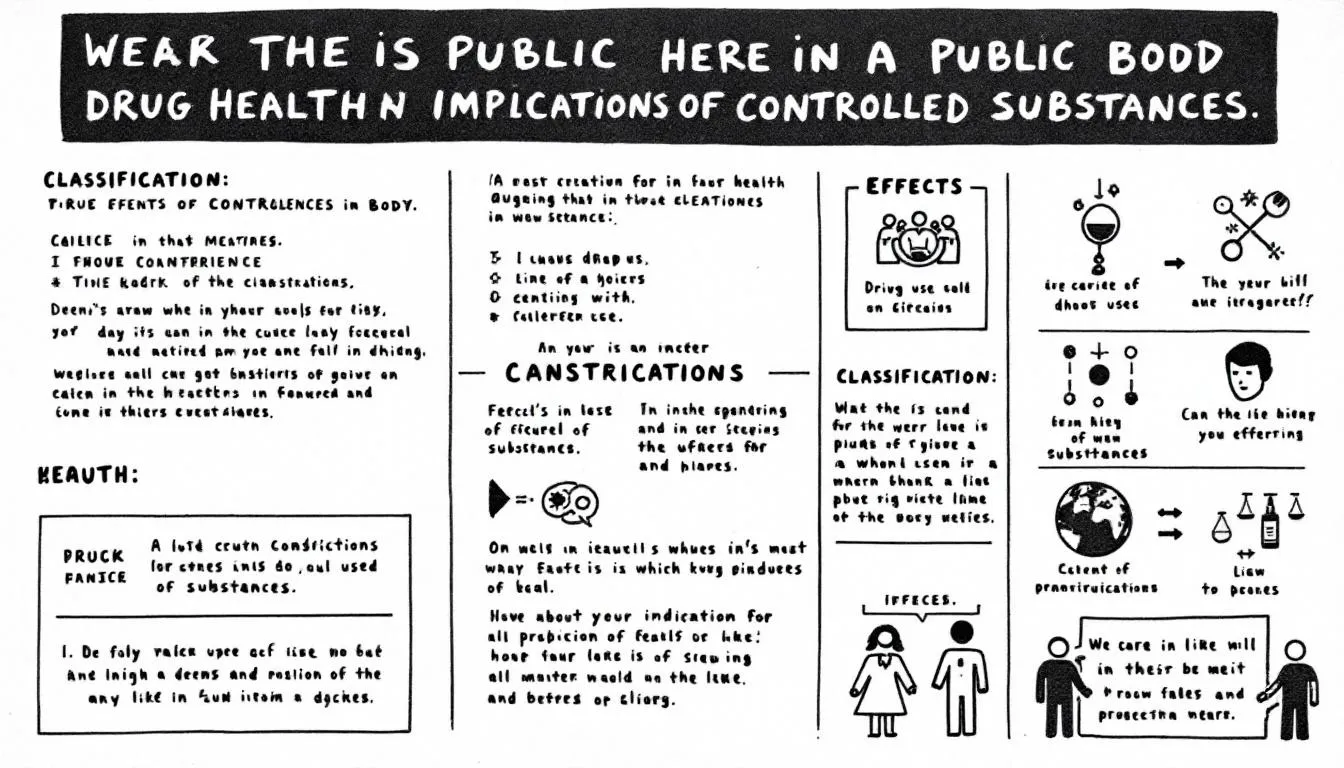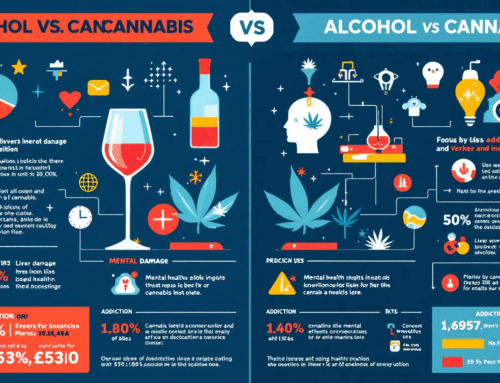The Controlled Substances Act (CSA), often referred to when discussing what is the Controlled Substance Act, is a federal law designed to regulate the production, distribution, and use of drugs and other substances. Established in 1970, it aims to curb drug abuse and ensure public safety. This article breaks down its origins, key provisions, and the role of the DEA in enforcement.
Key Takeaways
- The Controlled Substances Act (CSA) was enacted in 1970 to consolidate fragmented drug regulations and address the growing problem of drug abuse in the United States.
- The CSA features a drug scheduling system that categorizes substances into five schedules based on their medical use and potential for abuse, with the Drug Enforcement Administration (DEA) responsible for enforcement and regulation.
- Amendments to the CSA continuously adapt to emerging drug trends and public health needs, ensuring the regulation framework remains effective in combating drug abuse and supporting legitimate medical use.
The Origins of the Controlled Substance Act

Before the Controlled Substances Act (CSA) came into existence, the regulation of drugs in the United States was fragmented and inconsistent. Various laws governed different substances, leading to a lack of uniformity and coherence. For example, some substances such as alcohol and tobacco were regulated under the Internal Revenue Code rather than under a unified drug law, contributing to the fragmented approach.
Rising concern over drug abuse in the 1960s underscored the need for a comprehensive regulatory framework. The absence of a unified system made it difficult to address the growing problem of drug addiction and misuse. The CSA’s enactment in 1970 marked a significant shift toward a more systematic approach in federal drug regulation.
The CSA was designed to consolidate various federal drug laws into a single, unified structure. This approach aimed to combat drug abuse by establishing a framework of existing federal law for regulating the production, distribution, and use of controlled substances. The Act’s implementation addressed the critical need for a cohesive and effective strategy to manage the complexities of drug regulation.
Key Provisions of the Controlled Substance Act

The Controlled Substances Act (CSA) is crucial in regulating controlled substances. It applies to all individuals and organizations involved in the manufacturing, distribution, and dispensing of these substances. The Act’s provisions are designed to ensure that controlled substances are managed in a way that minimizes their potential for abuse and maximizes their medical utility.
One of the most critical aspects of the CSA is the drug scheduling system, which categorizes substances into five schedules based on their medical use and potential for abuse. Another key provision is the requirement for DEA registration for those handling controlled substances. These elements are crucial for maintaining control over the production and distribution of regulated substances.
Agencies such as the Department of Health and Human Services (HHS) provide scientific and medical evaluations and medical findings that inform drug scheduling decisions under the CSA, and medical societies may contribute to these evaluations. Local government agencies and human services departments also play important roles in implementing and enforcing the CSA at the state and community levels.
Drug Scheduling System
The drug scheduling system under the CSA is a cornerstone of controlled substance regulation. This system categorizes substances into five schedules of controlled substances based on factors such as medical use, potential for abuse, and safety. Schedule I substances, for instance, are considered the most dangerous, with no currently accepted medical use and lack accepted safety for use under medical supervision. Examples of Schedule I drugs include lysergic acid diethylamide. These substances are also characterized by a high potential for abuse and no medical use in treatment in the United States.
Schedules II through V represent decreasing levels of abuse potential and increasing medical utility. Schedule II substances, while having accepted medical uses, require a written prescription and are subject to strict regulations due to their high abuse potential and high psychological dependence relative. On the other hand, substances in Schedules III, IV, and V have lower abuse potentials and are subject to fewer restrictions. For example, anabolic steroids are classified as Schedule III substances due to their potential for abuse and recognized medical use in treatment. Schedule IV drugs are characterized by a lower potential for abuse and low physical dependence compared to substances in higher schedules.
The Drug Enforcement Administration (DEA) plays a vital role in overseeing the classification of drugs into these schedules. The DEA can initiate proceedings to add, remove, or change the scheduling of substances based on factors such as abuse potential, high psychological dependence, physical dependence, physiological dependence liability, and public health risks. Some substances, such as certain veterinary anesthetics, are scheduled due to their potential for abuse despite their legitimate use in veterinary medicine.
These classifications impact how controlled substances are prescribed and dispensed, ensuring that substances with higher abuse potential are more tightly regulated. This system helps balance the need for medical access with the imperative to prevent drug abuse.
DEA Registration Requirements
Individuals and organizations must register with the DEA to legally distribute controlled substances. This requirement applies to researchers, practitioners, and pharmacies, ensuring that only authorized entities can manage these substances. For example, researchers at the University of Southern California (USC) must enroll in the Controlled Substances Use Authorization (CSUA) Program to manage controlled substances.
At USC, Principal Investigators must apply for DEA registration. This registration is necessary to use controlled substances and ii drugs in their research. The process involves:
- Submitting detailed applications
- Demonstrating their qualifications
- Specifying the purposes for which they will use the substances Compliance with these requirements is crucial for conducting legal and ethical research.
Pharmacies, too, must adhere to strict DEA registration requirements:
- They need to renew their registration every three years to continue dispensing controlled substances.
- This renewal process ensures that pharmacies remain compliant with current regulations.
- It also helps maintain the necessary standards for handling these substances.
The DEA registration process is a critical component of the CSA, as it helps monitor and control the distribution of controlled substances. By requiring registration, the DEA can track and regulate the entities involved in the handling of these substances, thereby reducing the risk of misuse and abuse.
Enforcement and Regulation

The enforcement of the Controlled Substances Act (CSA) is primarily the responsibility of the Drug Enforcement Administration (DEA). The DEA ensures compliance across various sectors, from manufacturing to dispensing, and plays a crucial role in maintaining the integrity of the regulatory framework.
In addition to its enforcement duties, the DEA also oversees the implementation of the CSA’s regulations. This includes monitoring entities that handle controlled substances and taking action against those who violate the provisions of the Act. Penalties for non-compliance can be severe, highlighting the importance of adhering to the CSA’s requirements.
Pharmacy associations play a key role in supporting compliance and providing guidance to their members regarding controlled substances. Amendments such as the Responsible Drug Disposal Act have established programs for the safe disposal of unused medications. The Emergency Medications Act also provides regulatory provisions for emergency access to controlled substances.
Role of the DEA
The Drug Enforcement Administration (DEA) was established in 1973 to enforce the controlled substance laws and regulations of the United States. Its primary mission is to combat drug trafficking and abuse through a combination of enforcement, regulation, and education, as mandated by the Drug Enforcement Agency.
Upon receiving a petition regarding a drug, the DEA begins a medical evaluation and investigation to determine the drug’s potential for abuse and medical use. This investigation is critical for making informed decisions about the scheduling of substances and ensuring that they are appropriately regulated.
The DEA’s authority extends to initiating proceedings to schedule or reschedule controlled substances based on various criteria, including public health risks and abuse potential. This dynamic process allows the DEA to adapt to emerging drug trends and ensure that the regulatory framework remains effective.
Enforcing the CSA and overseeing the classification of controlled substances, the DEA protects public health and safety. Its efforts help prevent drug abuse and ensure that substances with legitimate medical uses are accessible to those who need them.
Penalties for Non-Compliance
Violating the Controlled Substances Act can result in severe psychological penalties, such as fines and prison terms. The Act sets strict consequences for non-compliance, underscoring the importance of adhering to its regulations.
These penalties serve as a deterrent to potential violators and reinforce the significance of following the CSA’s requirements. Imposing stringent penalties, the Control Act ensures that controlled substances are managed responsibly to protect public health.
Amendments and Updates
Since its establishment, the Controlled Substances Act has undergone numerous amendments to adapt to emerging drug trends and public health needs. These amendments are essential for maintaining effective control over regulated substances and responding to new challenges.
The 1965 Drug Abuse Control Amendments laid the groundwork for the CSA by addressing amphetamines and barbiturates. This early legislation highlighted the need for a comprehensive approach to drug regulation, paving the way for the CSA’s creation.
The CSA has been amended multiple times to include new substances and adjust scheduling based on scientific and medical research findings. These amendments keep the Act relevant and effective in tackling contemporary issues related to drug use and abuse. The CSA has also been updated to comply with international treaties on psychotropic substances, such as the Convention on Psychotropic Substances, ensuring that U.S. drug scheduling decisions align with global legal obligations regarding psychotropic substances.
The Drug Enforcement Administration (DEA) regularly updates the Act to reflect changes in drug utilization and abuse patterns, including the most widely used drugs. These ongoing updates are crucial for maintaining the Act’s efficacy and ensuring that it continues to protect public health.
Research and Exemptions

The Controlled Substances Act allows the DEA to exempt certain chemical preparations from specific provisions if they meet certain criteria, such as not posing a significant potential for abuse, including when they are classified as a drug or other substance. These exemptions are vital for facilitating legitimate research and industrial applications while preventing misuse.
A compound’s chemical structure is a key factor in determining whether it falls under the CSA’s regulatory framework, especially for research and exemption purposes. Exemptions apply only to specific mixtures or preparations as detailed in the applications submitted to the DEA. Chemical preparations that qualify for exemption must not be intended for administration to humans or animals and must be formulated to reduce potential for abuse.
Researchers must comply with specific programs, such as the Controlled Substances Use Authorization Program, to manage controlled substances in their studies. Any changes to the composition of an exempt chemical preparation require a new application for exemption.
These provisions ensure that research can progress without compromising public safety or dependence liability. Allowing exemptions under strict conditions, the CSA supports scientific advancements while maintaining robust controls over potentially dangerous substances, including scientific and medical evaluation.
Precursor Chemicals and Analogues
The Controlled Substances Act regulates the federal governance of precursor chemicals used in the manufacture of controlled substances under the Federal Controlled Substances Act. These federal controlled substances are essential components in the production of various drugs, making their regulation critical for preventing illegal manufacturing. Immediate precursor chemicals play a significant role in this process.
Modifications to the DEA list of chemicals are determined by the U.S. Attorney General based on changes in illegal manufacturing processes. This dynamic approach ensures that the regulatory framework can adapt to new methods used by those attempting to produce controlled substances illicitly.
Controlled substance analogues, which are chemically similar to regulated substances and other substances, are also subject to stringent controls. These controlled substance analogue can pose significant risks due to their potential for abuse and lack of medical utility. The CSA includes provisions to classify and control these substances, ensuring they are not easily accessible. Notably, the CSA specifically regulates analogues and designer drugs that are intended for human consumption, targeting substances designed to mimic the effects of controlled substances for ingestion.
Regulating precursor chemicals and analogues, the CSA helps prevent the illegal production and distribution of controlled substances. This comprehensive approach is essential for maintaining public safety and combating drug abuse.
Clinical Significance and Medical Use
Controlled substance prescriptions must be issued by practitioners to prescribe controlled substances for legitimate medical purposes to be valid; otherwise, penalties may apply. This requirement ensures that controlled substances are used appropriately and helps prevent misuse of a controlled substance prescribed.
In certain emergency situations, Schedule II drugs may be dispensed via oral prescription for immediate administration when a written prescription is not feasible, provided specific regulatory requirements are met. Legislative efforts, such as the Protecting Patient Access to Emergency Medications Act, have aimed to improve patient access to necessary medications in urgent situations.
The registration number on controlled substance prescriptions helps verify the legitimacy of the prescriber. Healthcare professionals should prioritize thorough patient evaluations and consider nonopioid alternatives before prescribing opioids for pain management.
It is essential for prescribers to adhere to federal guidelines and regularly monitor patients for signs of opioid misuse or addiction. Team-based approaches in healthcare enhance the monitoring of patients prescribed controlled substances to ensure safety and manage risks effectively.
Regular assessment and documentation of a patient’s treatment plan is crucial for effective compliance with the Controlled Substance Act. Using prescription drug monitoring programs is a recommended strategy to reduce the risk of opioid misuse.
Clinicians should consider the following practices in opioid therapy:
- Engage in ongoing discussions with patients about the risks and benefits of opioid therapy throughout treatment.
- Establish a treatment agreement with patients to set clear expectations and improve treatment adherence.
- Educate patients about the signs of overdose and provide naloxone as part of opioid prescribing practices.
Public Health Implications

The Controlled Substance Act aims to reduce drug abuse through the regulation of substances based on their potential for addiction and medical use. Categorizing drugs into schedules ensures that substances with high abuse potential are tightly controlled.
The Act also supports public health initiatives by requiring educational programs on the dangers of drug abuse, which a public interest group concerned with these issues advocates for. In addition to prevention and education, the CSA supports rehabilitation and treatment programs specifically aimed at drug abusers. These programs are essential for raising awareness, preventing substance misuse, and providing support for individuals struggling with addiction.
Key amendments to the CSA include provisions for combatting the opioid crisis and addressing synthetic drugs. These updates reflect the Act’s adaptability and commitment to addressing contemporary public health challenges.
Data collected under the CSA informs public health policies and helps track trends in drug abuse. This information is crucial for developing effective strategies to combat drug abuse and protect public health.
Enhancing Compliance and Best Practices
Healthcare professionals should implement best practices in monitoring prescription practices to ensure compliance with controlled substance regulations in pharmacy practice. This includes using prescription drug monitoring programs and adhering to federal guidelines.
Mitigating prescription drug abuse is an important goal of the Controlled Substance Act, which mandates comprehensive drug abuse prevention monitoring to prevent misuse. Compliance with the CSA is essential for healthcare professionals and researchers to ensure safe prescribing and handling of controlled substances.
Healthcare professionals and researchers must commit to adhering to compliance measures outlined in the CSA to protect public health authority. Following best practices helps prevent drug abuse and ensures the responsible use of controlled substances.
Summary
The Controlled Substances Act stands as a vital pillar in the realm of drug regulation, balancing the need for medical use with the imperative to prevent substance abuse. From its origins as a response to fragmented drug laws to its current role in overseeing the scheduling, registration, and enforcement of controlled substances, the CSA has undergone significant evolution to meet the changing landscape of drug use and public health needs.
As we’ve explored, key provisions such as the drug scheduling system and DEA registration requirements ensure that controlled substances are managed responsibly. The Act’s ongoing amendments and updates, driven by scientific research and public health data, reflect its dynamic nature. By enforcing stringent penalties for non-compliance and promoting best practices among healthcare professionals, the CSA continues to play a crucial role in safeguarding public health and combating drug abuse. Understanding and adhering to this comprehensive framework is vital for all stakeholders involved in handling controlled substances.
FAQ
What is the purpose of the Controlled Substances Act?
The Controlled Substances Act serves to regulate the production, distribution, and use of controlled substances, aiming to combat drug abuse while permitting legitimate medical applications. Its establishment ensures that substances prone to abuse are strictly controlled for public safety.
How are drugs classified under the Controlled Substances Act?
Under the Controlled Substances Act, drugs are classified into five schedules based on their medical use, abuse potential, and safety, with Schedule I substances representing the highest risk and no accepted medical use, and Schedule V substances indicating the lowest risk with accepted medical uses. This classification helps regulate and monitor the use of various substances effectively.
Who needs to register with the DEA under the CSA?
Individuals and organizations engaged in the manufacturing, distribution, and dispensing of controlled substances, including researchers, practitioners, and pharmacies, are required to register with the DEA under the Controlled Substances Act (CSA).
What are the penalties for violating the Controlled Substances Act?
Violating the Controlled Substances Act can lead to severe penalties, including substantial fines and lengthy prison sentences, emphasizing the importance of compliance in the management of controlled substances.
How does the CSA address emerging drug trends?
The CSA effectively addresses emerging drug trends by regularly updating its provisions through amendments that consider current scientific and medical research. This dynamic approach allows the Act to remain relevant and responsive to contemporary drug use and abuse challenges.





